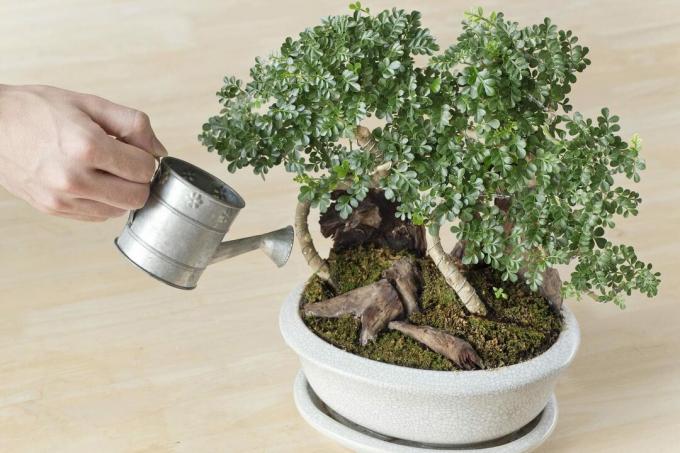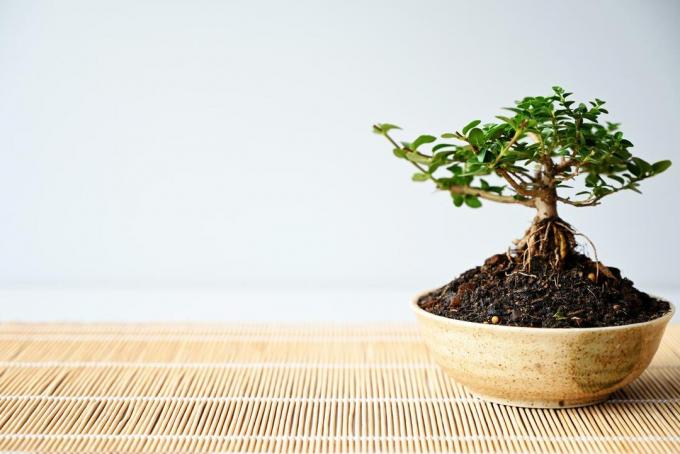The right water supply is crucial for the bonsai to thrive. Here you can find out what to consider when watering bonsai.

Due to the shell culture, there is hardly any scope for mistakes when caring for a bonsai. Casting in particular can quickly become a source of error here. Because the limited shell volume and the rather permeable bonsai soil make frequent watering necessary - and too frequent watering a problem. How often it has to be poured in the end depends on several factors, which we would like to introduce to you below.
Like any plant, the bonsai needs water to survive. Due to the isolated culture form of the bonsai in a bowl, careful attention must be paid to the needs-based water supply. This is even more difficult with bonsai than with most other potted plants, because the pods usually offer very little substrate to store water. In addition Bonsai soil consist to a large extent of inorganic materials and are difficult to store water anyway. Bonsais have to be watered at relatively short intervals. But not only the casting intervals and the casting method are decisive - also the choice of a suitable culture dish and a suitable one
Bonsai soil is essential. We clarify all questions about watering bonsai.tip: Unfortunately, enlarging the bonsai pot is not an option that could solve the watering problem. Because an enlargement of the root space would lead to - atypical bonsai - strong growth. Even substrates that store water well are not a good idea: They lead to poor root ventilation and thus quickly to a lack of oxygen at the roots and root diseases.
When should you water your bonsai?
With bonsai, the watering rhythm should be adapted to the individual plant. If you water without considering the bonsai, you run the risk of waterlogging or the complete drying out of the substrate particularly quickly with the shell culture. However, neither should ever happen. You should therefore water your bonsai as soon as the substrate has dried on the surface. With conifers and succulents, the substrate can sometimes be a little drier. You can easily recognize that it is drying by the lightening of the substrate or by simply touching it. It is best to check your bonsai substrate daily. Because especially in summer it can happen that you have to reach for the watering can several times a day. On hot days, water only in the morning or evening hours. Even in winter you should always keep the substrate moist. Here, however, the watering intervals are much longer due to the reduced water consumption of the bonsai. Bonsai that overwinter in the garden are only watered on frost-free days. When a bonsai has to be watered depends on the drought tolerance of the species, the substrate and the climate.

Summary: when to water bonsai?
- Water as soon as the substrate has dried on the surface (check daily!)
- Conifers and succulents are more drought-resistant than deciduous bonsai
- Keep the substrate moist even in winter
tip: High quality Bonsai soil are airy and still store and distribute the irrigation water effectively. For example, swellable clay minerals are responsible for this, which also absorb nutrients and release them when required.
How often and how much do you have to water bonsai?
So there is no fixed period for the casting interval. Rather, the time it takes until you next water your bonsai depends on a number of factors:
- Water requirement of the respective plant species: The general rule is: Conifers are rather little watered. Depending on the substrate, let it dry off as much as possible.
- Growth rate and age of the plant: The faster your bonsai grows, the higher the water consumption. Older bonsais grow much more slowly than younger plants and therefore need less water.
- Season and temperature: In summer the water requirement is higher than in winter due to evaporation from sunshine and shoot growth. This is where the plants rest and are therefore watered less. The following applies: the warmer the bonsai is in winter, the more water it needs in the darker season. Indoor bonsais that are in the heated apartment therefore regularly need water even in winter.
- Water storage properties of the Bonsai soil: The higher the proportion of organic substrate, the higher the water storage capacity. This also extends the casting intervals.
- Size of the plant: Compared to a small bonsai, a large bonsai has more biomass that evaporates water. As a result, the basic need for water is also higher.
- Location: The sunnier your bonsai is, the more irrigation water the tree loses through evaporation. Evaporation is highest at the sunny window seat.
- Surface of the planter bowl: The surface of the planter also influences evaporation. The larger this is, the more water evaporates and it has to be poured more often.

It's best not to just pay attention to the surroundings and that Substrate Of your bonsai. Also, find out about your specific needs Bonsai style regarding the water requirement in order to be able to better plan your watering runs.
How is a bonsai properly watered?
To properly water your bonsai, you need to soak the substrate completely. To water your bonsai, do the following:
- Always use rainwater or soft tap water at room temperature
- Water with a watering can until the water flows out of the bottom of the bowl
- Repeat the process after a few minutes
Hard tap water should be avoided in order to avoid deposits on the roots and on the vessel as well as an increase in the pH value. Alternatively, you can use the dipping method for smaller bonsai. To do this, immerse the bowl in a container with water for a few minutes until no more bubbles rise to the surface of the water. During this time, the substrate can soak up well. Then let the excess water run off.
Tip: For heavily clayey Bonsai soil you should always resort to the immersion procedure.
In order for you to be able to water your bonsai properly, your bonsai pot absolutely needs a drainage hole. Otherwise the water cannot run off and waterlogging will build up. If waterlogging occurs, your bonsai will react with brown leaves, which will sooner or later be shed, and dead branches. You can find more reasons for leaf shedding on bonsai here. at Bonsai speciesIf you come from tropical areas and are used to a humid climate, you should regularly use the water atomizer. How to increase the humidity. In winter, this is particularly important for indoor bonsai to compensate for the dry heating air.

Summary: how often and how much water bonsai?
- How often you water depends on many factors: So keep an eye on your bonsai
- Water soaking with soft tap water or rainwater
- Use immersion methods for clayey substrates
- Spray bonsais that need high humidity regularly
- Always use a bowl with a drainage hole to avoid waterlogging
In addition to water, bonsai trees need nutrients to grow properly. Everything for the right one Fertilizing bonsai can be read here.
Many thanks to Floragard for their support!
